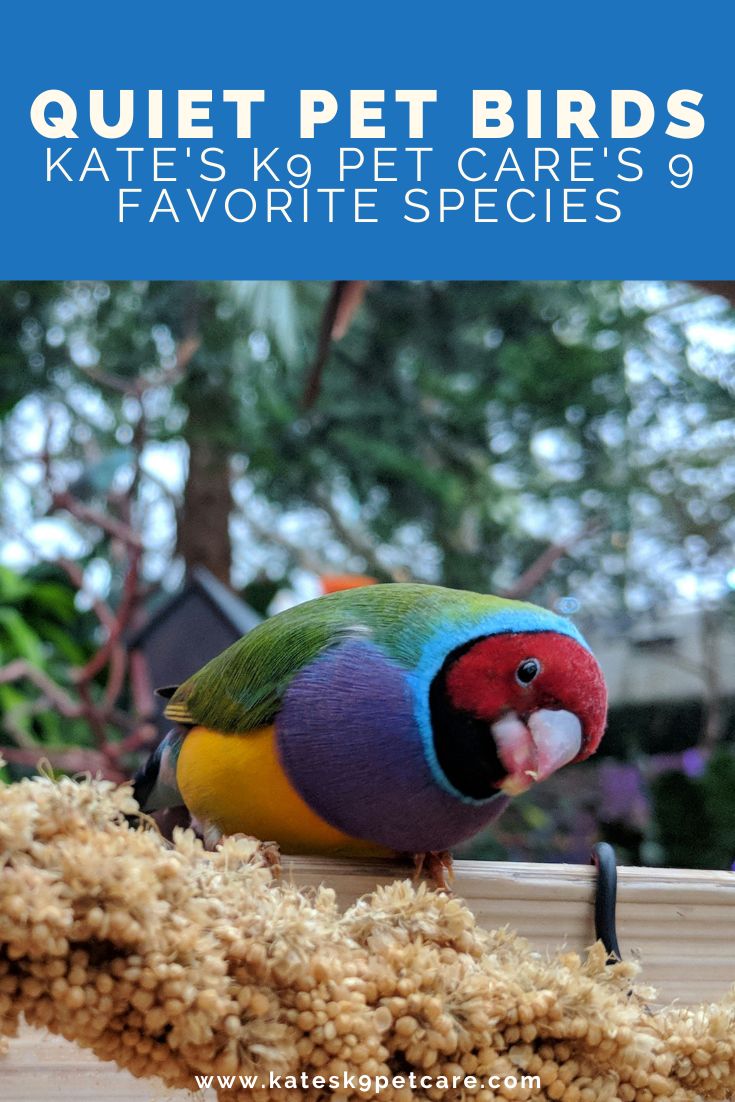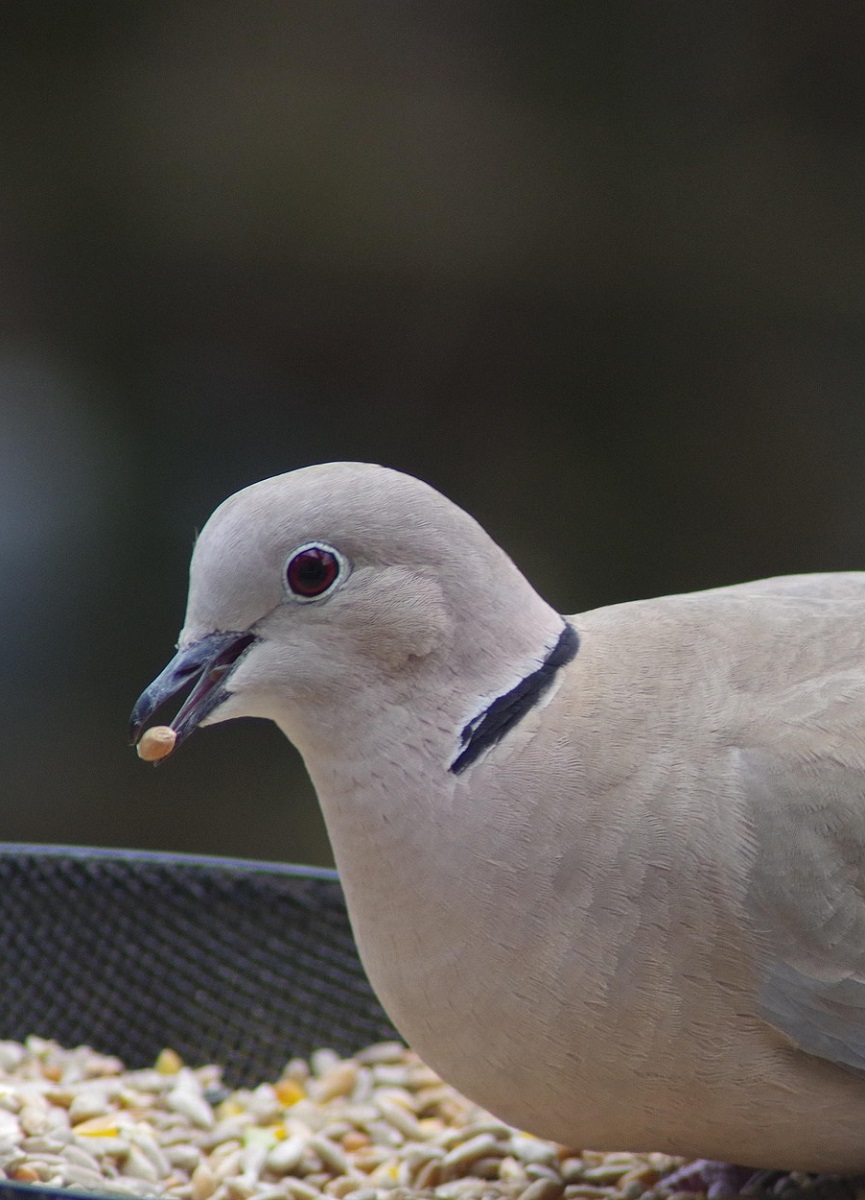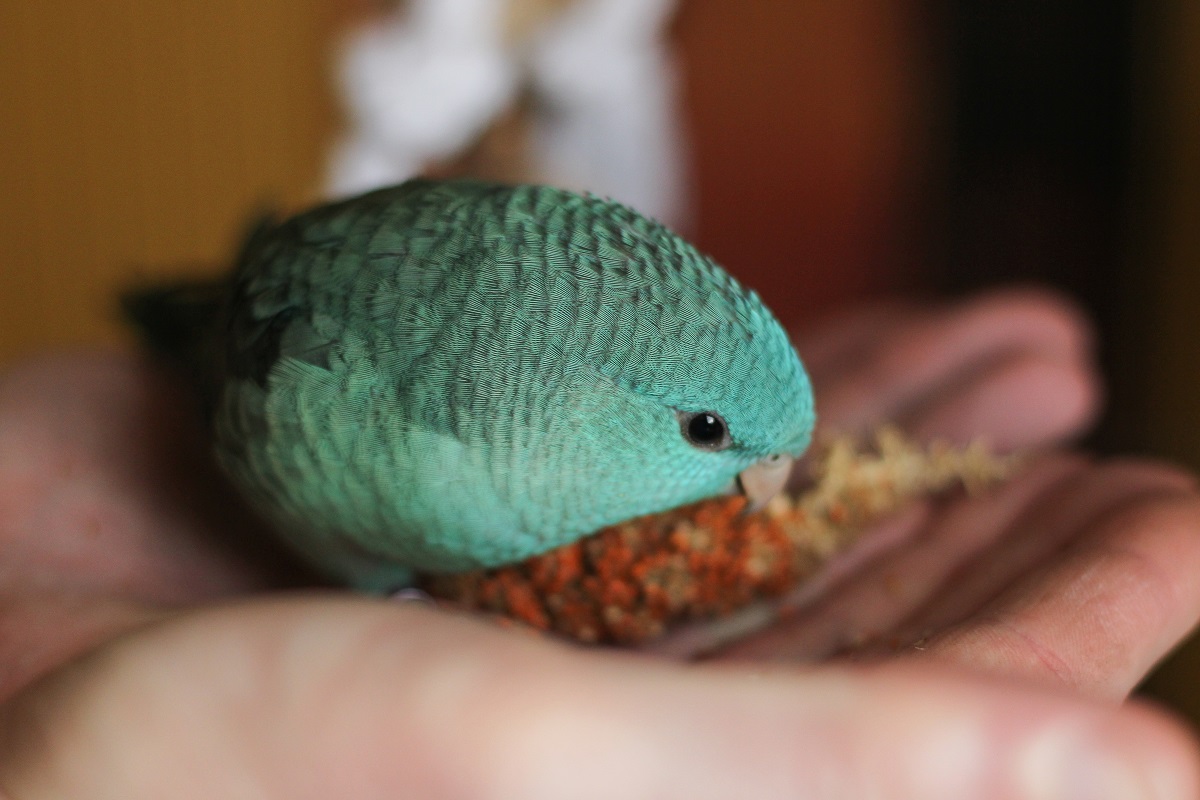Thinking about adding a pet bird to your family, but worried about their potential for loudness? Good thinking: most birds aren’t exactly quiet. Many of us are apartment dwellers who can’t afford to upset our neighbors or are sensitive to noise ourselves, so it’s important to consider your choice carefully. Which are the quietest pet birds?
Let’s go into 9 pet birds that won’t raise hell—at least not regularly. For clarity, we’ll rate them on a scale of one to five. One speaker emoji (🔊) means you won’t be able to hear this species if you go into the next room, while five speaker emojis means “the neighbors might just complain”. Ten speaker emojis would be equivalent to a screaming macaw parrot, but we’re definitely not including those on this list!
The myth of the quiet bird
Before we dive in, we’d like to clarify that “quiet pet birds” refers to pet birds that are quiet compared to other pet birds. No bird can be considered silent; that’s just not how they work. If you’re very sensitive to noise, a feathered pet probably simply isn’t for you—unless you want to spend your days walking around the house wearing noise-cancelling headphones. We think it’s important to mention this: noise complaints are one of the main reasons so many birds (especially parrots) are surrendered or even abandoned every year.
If you think about it, it all makes a lot of sense. After all, birds are prey animals that tend to exist in social groups (flocks) for safety purposes. In order to communicate with each other while they’re in flight or sitting in different trees, many have developed the ability to yell pretty loudly. It’s in their nature to use this ability to constantly verify their flock is still there.
In addition to making sure they’re safe and surrounded by their flock, birds also use noise as a way of flirting. Any cockatiel or budgie owner will know the familiar songs that males produce as a way of wooing their female flock mates, and the ringneck dove’s flirty coo is iconic. If you want a pet parrot or other type of bird, even if you opt for a “quiet” species, make sure you can handle their calls.

Types of noise
Speaking of noise: when choosing a bird species to add to your family, it can really help to take some time to figure out which types of sounds you’re sensitive to—and which might carry through the walls and bother your neighbors. Again, many birds, particularly parrots, are abandoned because their owners weren’t prepared for the amount of noise they made. Make sure yours doesn’t become one of them! It can really help to visit other people who keep birds, head to your local bird rescue, or try YouTube to listen to the different species before you make a decision.
Different people are sensitive to different kinds of noise. Some birds produce a steady stream of sound but may not be very loud. Others normally only vocalize for a few short periods a day, but produce much higher decibel levels. The pitch can really vary as well. A cooing dove may not pop your eardrums, but it can be incessant! When choosing a bird, it can really help to take some time to figure out which types of sounds you’re less sensitive to, so you don’t end up going crazy later.
Quietest pet birds: Parrots
Parrotlet (Forpus sp.) 🔊🔊🔊
One common appearance on lists of the quietest pet birds are parrotlets from the genus Forpus, such as the Pacific parrotlet. These are actually the smallest parrots to be kept as pets, with some of them weighing as little as 25 grams even when fully grown! With small parrots come small noises, and although a parrotlet can definitely cause a ruckus, it’s not going to be nearly as crazy as with their larger cousins. Additionally, parrotlets don’t make noise all day. If yours does burst into screams, it usually won’t last longer than a couple of minutes.
As far as apartment living goes, parrotlets usually make a good choice, unless your neighbors are very sensitive. Their ‘meeps’ are high-pitched, which doesn’t travel as well through walls as lower-pitched noises do.
Here’s an example of what a parrotlet sounds like when it does decide to be as loud as it can: Parrotlet screeching.

Rosy Bourke parakeet (Neopsephotus bourkii) 🔊🔊
The little Australian Bourke’s parakeet is what one could call a very polite parrot. It doesn’t squabble with other birds, is generally very calm, and doesn’t tend to get very loud at all. Closely related to the grass parakeets from the genus Neophema (which are also on the quiet side), Bourke parakeets are one of those species that tends to produce a constant stream of chatter. These twitters are not bothersome to most, though, and nor are their calls when they do decide they need to seek contact with their flock.
When it comes to apartment birds, most Bourke’s parakeet owners report it doesn’t get much better than these pretty pink parrots. And they sure make for a more creative choice than the ubiquitous budgie—which also happens to be more prone to bursting into screeches than a Bourke’s.
For an example of Bourke parrot singing, you can have a look at this video.

Budgie (Melopsittacus undulatus) 🔊🔊🔊
The ubiquitous budgie is one of the most popular pet birds. There are many reasons for this, one of them being their relatively low noise levels. Sure, a flock of budgies can definitely raise hell—and they’re definitely louder than the aforementioned rosy Bourkes. Still, a solo budgie or a pair can generally be considered pretty quiet as far as birds go.
Female budgies are usually less noisy than the males. It’s the boys that produce a constant stream of chatter and singing, most of which shouldn’t be too bothersome. A happy budgie twittering away is more of a happy sound than an annoying one!
The only time a budgie’s vocalizations really become grating is when they overdo it with the flock calls. Those repeated ‘EEP’ noises do get pretty loud, but luckily, a happy and healthy budgie should keep these chattering storms limited to a few times a day.
For an example of what budgie flock calls sound like, you can try this video.

Lineolated parakeet (Bolborhynchus lineola) 🔊🔊
Another small parakeet makes the list! The lineolated parakeet (“linnie”) is native to mountainous regions in Central and South America. Considered one of the calmest members of its family, this little parrot is definitely still a chatterbox, but the noise it produces doesn’t tend to be considered annoying. Linnie flock calls are a lot more shrill, though luckily they generally reserve those for a few short periods a day.
Lineolated parakeets make excellent pets for apartment dwellers. They’re solidly in the top 3 of quietest parrots, and as an added bonus, they’re tiny. Even budgies are larger than linnies in terms of length, although we’ll admit the latter are usually a little chunkier. All birds need a large cage and plenty of space to roam and explore, but linnies are definitely one of the more compact choices.
For an example of what a lineolated parakeet sounds when it decides to shatter the silence, check out this video: Screamer? Squaller? Singer?

Senegal parrot (Poicephalus senegalus) 🔊🔊🔊🔊
The largest parrot on this list, the Senegal parrot is native to West Africa. It’s one of the more popular parrot species—not just because Senegals can make incredibly loving companions, but also because their vocalizations tend to fall into the acceptable range for most people.
A parrot of this size has the capability of producing a pretty respectable decibel level, and it will use this capability from time to time. However, Senegals don’t tend to vocalize nearly as often as many other parrot species. That’s why they’re considered one of the better choices for apartment living.
A larger species like the Senegal parrot is obviously going to be a bit more of a risk in terms of noise than something like the tiny, ever-polite Bourke’s parrot. It makes a good choice for people who want the experience of keeping a bigger parrot and don’t mind one or two extra points on the noise scale.
Here’s what it sounds like when a Senegal decides to raise the roof: senegal parrot screaming.
Tip: If you like the idea of a larger parrot, you can also opt for one of the Pionus species. Their noise level is considered similar to that of a Senegal.

Cockatiel (Nymphicus hollandicus) 🔊🔊🔊
Another extremely popular pet parrot, the Australian cockatiel is smaller than a Senegal parrot but larger than the rest of the parrots on this list. They’re a big favorite among parrot enthusiasts for their sweet and calm nature, which truly makes them lovely pets for the right owner.
When it comes to noise, as with budgies, the females tend to be the quieter ones. They usually (though not always!) limit themselves to the occasional flock call. The males on the other hand use song as a way to express themselves, although it’s not something they do all day long like budgies tend to.
Cockatiels do vocalize. Their flock call are more or less acceptable in terms of shrillness, but they do also produce a more urgent screaming call that can be very annoying. Luckily, a happy cockatiel shouldn’t do this often. It can happen when their favorite person leaves or enters the room, or if they hear other birds.
Quietest pet birds: Other
Gouldian finch (Chloebia gouldiae) 🔊🔊
There are loads of different finch species out there, many of which are commonly kept as pets. The general consensus is that zebra finches and canaries are among the loudest of them. That being said, they’re all so small they usually don’t reach annoying levels, at least to most people. Additionally, their singing blends in with outside wild bird noises much more than parrot squawks do—who doesn’t love a cheerfully chirping canary?
Finch enthusiasts tend to agree that while they lack some of the personality of the other species, Gouldian finches are usually the quietest. They do vocalize for most of the day, but their peeps should be fine for all but the most sensitive folks. They are very unlikely to carry through walls and upset the neighbors. And can you believe the amazing plumage on these little birds?
For an example of what Gouldian finch song sounds like, you can have a look at this video: Gouldian finch singing happily.

Ringneck Dove (Streptopelia risoria) 🔊🔊
Some people scoff at the idea of keeping a pigeon or dove in one’s home. Aren’t those basically disease-riddled flying rats and best avoided? Although they can be very annoying in a city setting, let us tell you from personal experience: if you want to keep birds, doves and pigeons are actually at the top of our list of recommendations. It should be the Columbidae (pigeons), not the Psittaciformes (parrots) that dominate our homes!
Because pigeons are quite large, why not consider the ubiquitous and somewhat more compact ringneck dove? These pretty gray birds aren’t just more evenly tempered than parrots—well-socialized doves will be snuggly and very unlikely to ever lash out—but they’re also much, much quieter. We’ll be the first to admit that doves coo pretty much incessantly, but because their calls are relatively quiet and low-pitched, they’re unlikely to drive you or your neighbors to desperation.
Listen to Atlas the dove at his loudest: Coo and snack.

Diamond dove (Geopelia cuneata) 🔊
Don’t have space for a ringneck dove? Another example of a dove often kept indoors is the sweet, tiny diamond dove, an Australian native. These shy birds may look normal-sized in pictures, but when you actually get to see one, you’ll notice they’re more similar in size to something like a budgie (a parrot they, by the way, can sometimes be seen alongside in the wild). A great option for apartment dwellers who lack the space to accommodate larger birds.
Diamond doves are highly social birds, and they do use noise to communicate with each other. However, like ringnecks, they rarely do anything other than coo. Diamond dove coos almost sound like a human trying to imitate a pigeon coo. Keep in mind these doves tend to be somewhat shy and skittish, usually preferring to be left alone. If you’re looking for a bird that likes to be handled, the larger pigeons really do make better choices.
You can find an example of what diamond dove coos sound like here: Male diamond dove cooing.

Button quail (Turnix sp.) 🔊
Button quail are generally kept outdoors; most folks find them a bit too messy and smelly to make good indoor pets. Still, we think they deserve a mention on the list, as they really barely make any noise at all. Although these tiny terrestrial birds are not really worth raising for meat or eggs, they make fun pets. And how absolutely adorable are they?! This is the smallest quail species, topping out at roughly the size of a canary—though a lot fatter, weighing almost twice as much.
Like all birds on this list, button quail do make noise. It’s hard to feel upset at them for it, though: the coos and meeps they produce are pretty sweet and not too loud. For those who do own an aviary and don’t want to add even more noise to the existing racket (which tends to be considerable, depending on which birds you keep!), quail are actually great additions to aviaries with finches or peaceful parrots. They bring life to the lower levels of the enclosure and won’t bother anyone.
An example of a group of button quail emitting their typical meeps can be found here: Button Quails – Sing It Boys.

Conclusion: Quietest pet birds
Even if you live in an apartment or are sensitive to noise, there are still some pet bird species you may be able to keep. Just don’t expect a totally quiet pet—you’re better off setting up an aquarium or something of the sort if you don’t want any noise whatsoever!







